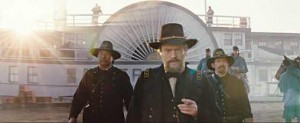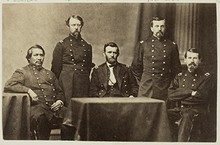Steven Spielberg’s Lincoln takes history seriously. While some of the details may be contrived – there is no record of black Union Army soldiers being assigned to greet the Confederate commissioners en route to negotiate a peace treaty – the film for the most part follows fact scrupulously. Much of the dialogue is based on contemporary letters and journalistic accounts.
Spielberg’s obsession with historical accuracy extends even to background.
In two scenes featuring General Grant, viewers will notice standing behind him the silent, striking presence of an American Indian in the uniform of a Union Army officer.
(Parker, left, in film)
He is not there for setting. The man depicted is Ely Parker, a lawyer, engineer, life-long friend of Grant, and full-blooded Seneca, whose life story would justify a movie of its own.
It deserves telling.
Ely Parker was born in 1828 at IndianFalls on the Tonawanda Indian Reservation, near Akron, New York. His father, Seneca Chief William Parker was a veteran of the War of 1812. In his long and eventful life, Parker himself would rise to the rank of Chief, and to wear the Red Jacket medal, originally awarded by President George Washington to Chief Red Jacket after their peace negotiations, and inherited by Jimmy Johnson, Parker’s grandfather.
Parker was educated on the Reservation, then taken up to Canada where he was taught to hunt and fish.
A brilliant, bilingual student, Parker attended college, then “read the law” at the offices of Angel and Rice in Ellicottville, New York. He was not allowed to take the New York bar exam because, as an American Indian, he was not a citizen.
Denied a chance to pursue a legal career, Parker caught a break when he met a young lawyer named Louis Henry Morgan at a bookstore. Morgan, a great admirer of Indian customs, relied on Parker as a source, and dedicated his classic work, The Iroquois, to him.
Morgan was well connected in society, and he used those connections to help his Indian friend gain admission to Rensselaer Polytechnic Institute, where he studied engineering. After graduation, Parker’s career flourished. He worked on the GeneseeValleyCanal in 1849, and on the Erie Canal. Later, he accepted the position of superintendent of construction in Galena, Illinois, where he met a down-and-out store clerk and army veteran named Ulysses S. Grant.
In 1846, a Seneca named John Blacksmith sued the Ogden Land Company for trespass upon a sawmill yard on the Reservation. The Company claimed rights to the land under a treaty with the Indians which had been ratified by Congress. The case wound its way through the New York state courts for a decade. Blacksmith died, and Parker, as administrator of his estate, joined his widow as plaintiffs.
The case ultimately reached the U.S. Supreme Court, where the Indians were represented by John H. Martindale. But Ely Parker attended and apparently played a decisive role in the argument. According to a New York Times account: “All who heard their cases argued before the Supreme Court of the United States … will recollect seeing this same Indian, and that he was well posted on the points he desired his counsel to press upon the attention of the Court.”
A letter-writer to the New York Times, who criticized their coverage of the case because it seemed to imply that the Indians “were very nearly the equal … of their white neighbors,” ironically reinforced the impression that Ely Parker was the brains behind the legal case:
I have not a word to say in the disparagement of the intellectual ability of Ely S. Parker, their head chief, and cheerfully unite with [the Times correspondent] in awarding him the credit for making valuable suggestions to his counsel on the argument of the case in the Supreme Court of the United States. Indeed, I am inclined to the belief, that to him is due the credit of originating and suggesting to his counsel the only available point in the case, and the one on which it was there decided, for the case had been ten years in the Courts of this State, and this point was never before made, nor was it made in the Supreme Court of the United States, in the original brief of counsel for the Indians, filed pursuant to the rules of the Court.
The winning argument, apparently contributed by Parker, was that since the treaty had been made by the Indians with the Government, only the Government, not the Ogden Land Company, could enforce it.
With the outbreak of the Civil War, Parker proposed raising a regiment of Iroquois volunteers to fight for the Union. The Governor of New York rejected the offer. He tried to enlist in the Army as an engineer. Secretary of War Simon Cameron told him that, as an Indian, he could not.
Finally, Parker used his contact with his old friend Grant to obtain a commission as a captain in the engineers in May 1863. After playing a significant role in the Siege of Vicksburg (he was praised by the commanding general), he was transferred to General Grant’s staff during the Chattanooga Campaign. He stayed with Grant for the duration of the war, rising to the rank of lieutenant colonel. Despite his erudition and perfect English, enlisted men referred to Parker as “the Indian,” “Grant’s Indian,”or “Big Indian.”
His legal training played as much a role as his engineering background during his military service. He wrote much of Grant’s correspondence. He also penned one of the most important documents of the Civil War: the articles of surrender, which are in his handwriting.
Parker was at Appomattox when General Robert E. Lee arrived to sign the articles. Lee mistakenly assumed Parker was black, and ignored him. Realizing his mistake, Lee apologized and shook his hand, saying , “I am glad to see one real American here.” Parker responded, “We are all Americans, sir.”
Parker remained Grant’s military secretary after the war, eventually leaving the service with the rank of brigadier-general.
On Christmas Day, 1867, Parker married Miss Minnie Orton Sackett. General Grant was his best man. Ely and Minnie had a daughter, Maud Theresa Parker, who lived until 1956.
After his election as President, Grant appointed Parker Commissioner of Indian Affairs, the first Indian to hold the post. His friend and supporter Louis Henry Morgan would later follow him in that job.
It would be sweet to recount that Ely Parker’s life thereafter was happy and prosperous, but that is not the way history works. He was caught up, undeservedly, in the atmosphere of corruption permeating the Grant administration. Although a congressional investigation cleared him of all charges, he resigned at its conclusion. He invested in the stock market, made money, then lost it all in the Panic of 1873. Eventually, he found work as a supply clerk at the New York Police Headquarters. He died in poverty in 1895. His left his wife only a carbon copy of the Appomattox articles of surrender.
Though generally unknown, Ely Parker is a hero among American Indians. Asa-Luke Twocrow, an Oglala Sioux who was working behind the scenes as a rigger on the film, called it a great honor to be tapped to play him. “It’s known that Ely was striving to improve relations between Native Americans and the white man,” Twocrow said, “and he was often chastised for it. It’s kind of a shame that he is not more widely known.”
Spielberg’s film, a serious Oscar contender, has increased interest in Abraham Lincoln and his times. Perhaps it will also generate interest in Ely Parker, a member of one of the continent’s oldest peoples, who fostered an end to that continent’s bloodiest conflict.
(Parker, left, in history)



I had read that Parker also “policed” Grant’s drinking.
Great story about Parker. Thanks for filling in the blanks. Jim
Fascinating story. Thank you so much for telling it. I only hope Mr. Spielberg, or some other Hollywood producer, might make a film of Ely Parker’s life. I’m sure it would be a success.